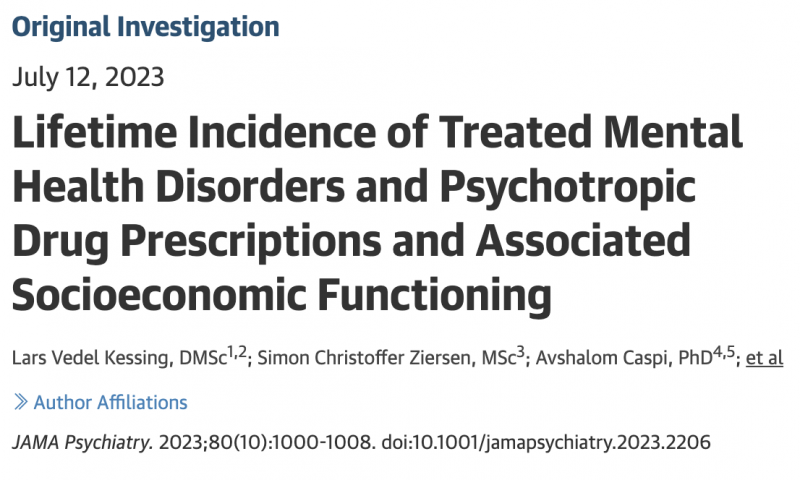80% of the Population Treated with Psychiatry
- November 2, 2023
- / Admin
- / Psychiatry

Lifetime Incidence of Treated Mental Health Disorders and Psychotropic Drug Prescriptions and Associated Socioeconomic Functioning
Lars Vedel Kessing, DMSc1,2; Simon Christoffer Ziersen, MSc3; Avshalom Caspi, PhD4,5; et al
JAMA Psychiatry. 2023;80(10):1000-1008. doi:10.1001/jamapsychiatry.2023.2206
Key Points
Question What is the lifetime risk of experiencing mental health disorder and/or receiving psychotropic medication and the association with long-term socioeconomic difficulties?
Findings In this cohort study, lifetime cumulative incidence of mental health disorder and/or prescription of psychotropics was greater than previously reported with about 80% of the population getting treatment for a mental health disorder in hospital settings or from general practitioners or private psychiatrists. Mental health disorder and prescription of psychotropics were associated with subsequent increased socioeconomic difficulties, including lower income, unemployment, and increased likelihood to live alone and to be unmarried.
Meaning These findings may be used to change attitudes toward mental health disorder, promote greater mental health literacy, and promote policies to support needed services.
Abstract
Importance Few studies have estimated the lifetime incidence of mental health disorders and the association with socioeconomic functioning.
Objective To investigate whether the lifetime incidence of treated mental health disorders is substantially higher than previously reported and estimate associations with long-term socioeconomic difficulties.
Design, Setting, and Participants This nationwide population-based register linkage study includes a randomly selected sample of 1.5 million individuals from the population of Denmark from 1995 to 2018. Data were analyzed from May 2022 to March 2023.
Main Outcomes and Measures Lifetime incidence of any treated mental health disorder in the general population was estimated from birth to age 100 years taking into account the competing risk of all-cause death and associations with socioeconomic functioning. Register measures were (1) from hospitals, a diagnosis of any mental health disorder at an inpatient/outpatient hospital contact; (2) from hospitals and prescription statistics, any mental health disorder/psychotropic prescription, including a hospital-contact diagnosis, or any psychotropic medication prescribed by physicians, including general practitioners or private psychiatrists; and (3) socioeconomic functioning as indicated by highest educational achievement, employment, income, residential status, and marital status.
Results Among a sample of 462 864 individuals with any mental health disorder, the median (IQR) age was 36.6 years (21.0-53.6 years), 233 747 (50.5%) were male, and 229 117 (49.5%) were female. Of these, 112 641 were registered with a hospital-contact mental health disorder diagnosis and 422 080 with a prescription of psychotropic medication. The cumulative incidence of a hospital-contact mental health disorder diagnosis was 29.0% (95% CI, 28.8-29.1), 31.8% (95% CI, 31.6-32.0) for females, and 26.1% (95% CI, 25.9-26.3) for males. When also considering psychotropic prescriptions, the cumulative incidence of any mental health disorder/psychotropic prescription was 82.6% (95% CI, 82.4-82.6), 87.5% (95% CI, 87.4-87.7) for females, and 76.7% (95% CI, 76.5-76.8) for males. Socioeconomic difficulties were associated with mental health disorder/psychotropic prescriptions, including lower income (hazard ratio [HR], 1.55; 95% CI, 1.53-1.56), increased unemployment or disability benefit (HR, 2.50; 95% CI, 2.47-2.53), and a greater likelihood of living alone (HR, 1.78; 95% CI, 1.76-1.80) and being unmarried (HR, 2.02; 95% CI, 2.01-2.04) during long-term follow-up. These rates were confirmed in 4 sensitivity analyses with the lowest being 74.8% (95% CI, 74.7-75.0) (1) by using varying exclusion periods, (2) by excluding prescriptions of anxiolytics and quetiapine that may be used for off-label indications, (3) by defining any mental health disorder/psychotropic prescription as any hospital-contact mental health disorder diagnosis or any psychotropic medication prescribed at least 2 times, and (4) by excluding individuals with somatic diagnoses for which psychotropics may be prescribed off-label.
Conclusions and Relevance This registry study of data from a large representative sample of the Danish population showed that the majority of individuals either received a diagnosis of a mental health disorder or were prescribed psychotropic medication during their lifetime, which was associated with subsequent socioeconomic difficulties. These findings may help change our understanding of normalcy and mental illness, reduce stigmatization, and further prompt rethinking the primary prevention of mental illness and future mental health clinical resources.
Read the Original Investigation on JAMA
WHO ARE THE “THEY” - THESE GLOBAL PREDATORS?
WHAT ARE THEIR MOTIVES AND THEIR PLANS FOR US?
HOW CAN WE DEFEND AGAINST THEM?
Covid-19 and the Global Predators: We are the Prey

 Psychiatric Drugs
Psychiatric Drugs
 Psychiatric Reform Accomplishments
Psychiatric Reform Accomplishments